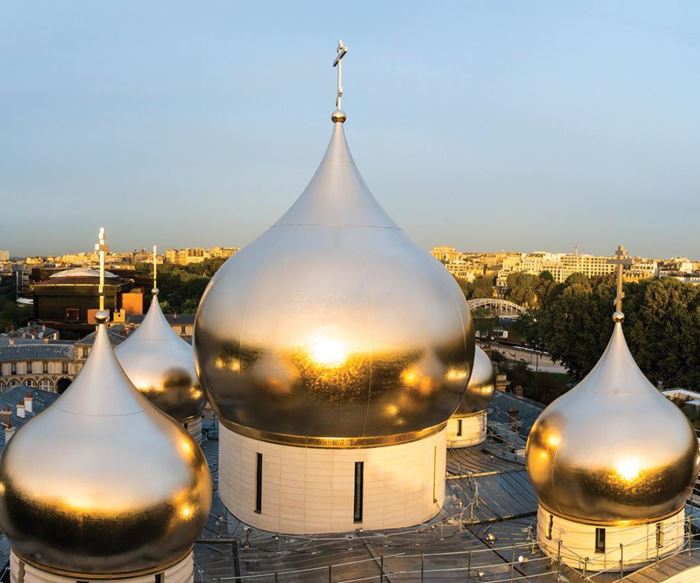Russian Orthodox cathedral in Paris topped with composite domes
Infused, multi-piece molded sections formed finished domes that reduced dead load on the final building structure by 80%.
When then-president Dmitry Medvedev signed a deal on behalf of Russia in 2010 to purchase a prized and sought-after Unesco-protected property near the Eiffel Tower in Paris to build a large Russian Orthodox cathedral complex, it caused a considerable controversy. This was due, in part, to concerns about the property’s sale to Russia and its proximity to sensitive French government buildings, but ultimately to its decidedly unorthodox original design, which was ridiculed in the French press until its withdrawal.
A new team, including architect Jean-Michel Wilmotte, French contracting giant Bouygues (Paris, France) and engineering consultants Calcul Méca (Nantes, France), was assembled and a new design put forward. Composites manufacturer Multiplast (Vannes, France), part of Groupe Carboman, got the nod to fabricate the five gilded domes that, in the revised plan, would crown the Sainte-Trinité Cathedral’s roof in traditional fashion, topping off a more muted contemporary visualization (see above photo).
The central dome, the largest, is 12m high and 12m in diameter. Composites were a necessity here, says Multiplast, to significantly reduce building dead loads — each composite dome is one-fifth the weight of a conventionally constructed dome.
Sicomin Epoxy Systems (Châteauneuf les Martigues, France) supplied the package of resins and reinforcements for molds and parts. Tooling was produced by Décision SA (Ecublens, Switzerland), one of the companies within Groupe Carboman. Décision infused a set of multiaxial glass fiber/balsa- reinforced molds, using Sicomin’s SR8100/SD7820 (120°C Tg) epoxy infusion system. Multiplast produced the parts using Sicomin’s SR8100/ SD4772 epoxy infusion system and a heavyweight quadraxial glass fabric (QX1180) combined with a woven 500-g/m2 glass fabric, which eliminated print-through and provided resin flow characteristics that reportedly prevented dry spots.
Guillaume Kemlin, a Multiplast engineer involved with the project, says the decision to produce the domes off site at the Multiplast facility created challenges but ultimately significantly shortened the project schedule and yielded great benefits. “The domes were too large to transport in one piece, so road width forced us to produce the domes in segments 4m wide,” he notes. “We utilized our digital tools to the maximum, producing the large dome in 13 segments and the four small domes in four segments.” But Sicomin could carry out extensive differential scanning calorimetry (DSC) testing in its laboratory to optimize the epoxy cure profile, ensuring dimensional stability of the finished parts. And after demolding, craftsmen were able to apply 86,000 leaves of real gold to the five domes’ segments (a 640m2 total surface area) under controlled conditions — a task nigh impossible at the job site. The segments then were transported to Paris for assembly on site.
The main dome was installed in March 2016 in the presence of religious and political dignitaries, and the facility officially opened on Oct. 19, 2016.
Related Content
-
CompoTech uses integrated loop technology to create high-performance mountain bike
CompoTech features its CDuro Epona mountain bike fitted with custom suspension forks, manufactured using its AFL winding and integrated loop technologies.
-
From the CW Archives: Airbus A400M cargo door
The inaugural CW From the Archives revisits Sara Black’s 2007 story on out-of-autoclave infusion used to fabricate the massive composite upper cargo door for the Airbus A400M military airlifter.
-
TU Munich develops cuboidal conformable tanks using carbon fiber composites for increased hydrogen storage
Flat tank enabling standard platform for BEV and FCEV uses thermoplastic and thermoset composites, overwrapped skeleton design in pursuit of 25% more H2 storage.

















.jpg;maxWidth=300;quality=90)
